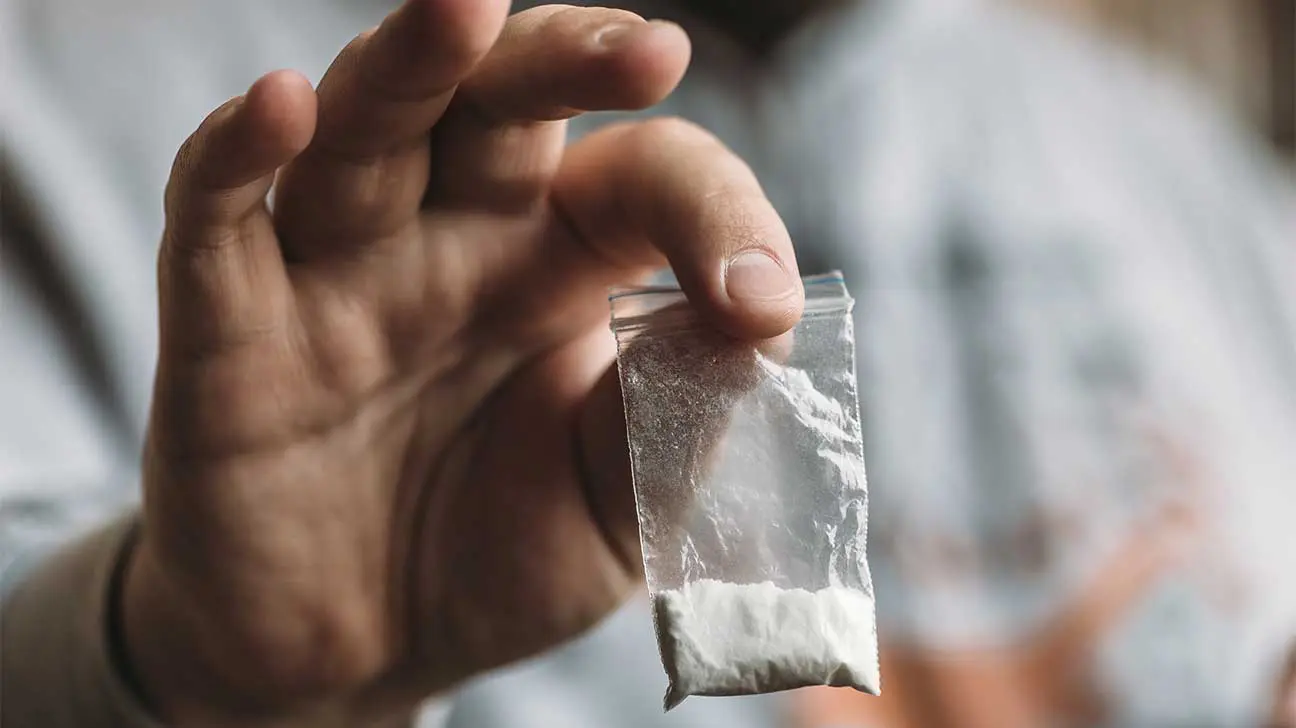Cocaine Addiction: Signs, Side Effects, And Treatment
Cocaine is a highly addictive stimulant drug derived from the coca plant. It may be snorted, smoked, injected, or used orally, and can cause drastic changes in moods, negatively impact physical health, and lead to or worsen mental health disorders including addiction.

Cocaine is a powerful and highly addictive stimulant that comes from the coca plant, which is native to South America.
For more than a century, cocaine has been illegal for recreational use due to its harmful effects on health, behavior, and the high risk for addiction.
According to the National Institute on Drug Abuse (NIDA), 1.3 million people aged 12 or older — that’s 0.5% — had a cocaine use disorder in the past year.
With important implications on the mind and body, cocaine use must be addressed and treated with evidence-based methods.
If you or a loved one are experimenting with cocaine, or have a known cocaine use disorder, learn the risks and effects of cocaine abuse and explore treatment options.
What Is Cocaine?
Cocaine is classified as a Schedule II stimulant drug. This means it currently has some accepted medical uses in the U.S., but it has a high risk of abuse.
Derived from the coca plant, cocaine is made through a process of chemical transformations where the coca leaves are dried and soaked in chemicals to form a liquid solution.
It may also be made into a powder or crystalized to form crack cocaine, a rock form of the drug.
Cocaine is available in two forms: the hydrochloride salt form and the freebase. Hydrochloride salt cocaine looks like a fine white powder.
Freebase cocaine, often referred to as “crack,” is the purest form of cocaine and is extremely potent.
Crack cocaine is produced to be smoked. The name “crack” comes from the crackling sound the drug makes when it’s being smoked.
History Of Cocaine
The coca plant, where cocaine comes from, originates from South America. It’s been used by indigenous groups in South America for centuries for healing, religious ceremonies, and more.
However, it wasn’t until the 1850s that scientists were able to extract pure cocaine from the coca plant.
When they discovered the powerful properties of extracted cocaine, the scientist believed they’d found a “wonder drug.”
Today, cocaine is recognized as one of the most addictive substances available.
Learn more about the history of cocaine abuse.
How Does Cocaine Work In The Body?
Cocaine is a highly addictive drug that can cause a powerful rush of energy and euphoria by acting on the brain’s reward and pleasure center.
The repeated use of cocaine or crack cocaine can disrupt the brain’s normal pattern of responding to stimuli.
Over time, this can make people crave more of the drug, and may lead to drastic effects on mood and behavior.
How Long Does Cocaine Affect The Body?
The stimulant can affect the body for up to two hours. A cocaine high lasts about 15 to 30 minutes, but some people may feel euphoria for one to two hours.
Cocaine can be detected in a person’s system for longer than this (about two to four days), depending on the testing method. In the hair, it can be detected for up to 90 days.
For women with infants, high concentrations of cocaine can be found in breast milk during active use.
Cocaine may remain in the breast milk at peak concentrations for about 12 hours, then slowly decrease until about the 36-hour mark.
Medical professionals recommend at least 24 hours between a mother’s last use and feeding her baby breast milk.
How Is Cocaine Abused?
There are four ways of abusing cocaine: orally, intranasally, intravenously, or by inhalation.
Here is how each route of cocaine administration works:
- Snorting cocaine: Cocaine is most often snorted by sniffing the powder form of cocaine into the nostrils.
- Smoking cocaine: It may also be smoked, inhaling the vapor into the lungs.
- Injecting cocaine: Cocaine may be dissolved into water and injected into the bloodstream. However, smoking produces effects almost just as quickly as injecting, so smoking is more common.
- Eating cocaine: Orally, people may rub cocaine into the gums with a method known as “gumming.”
- Freebasing cocaine: This refers to using pure cocaine, typically by smoking it with a glass pipe.
Cocaine’s Effect On The Body
Cocaine can have short-term effects on the body, such as a short-lived high, a burst of energy, and hypersensitivity to light, sound, and touch.
A person may also feel a number of long-term effects of using cocaine. This includes chemical dependence and increased mental health issues, such as anxiety and panic attacks.
Cocaine may affect the brain and body in the following ways:
- damage to nasal tissue (“cocaine nose”)
- nosebleeds
- difficulty swallowing
- an increased heart rate, increased blood pressure, stroke, risk of heart attack, and other effects on the heart from cocaine use
- weakened immune system
- risk of HIV from intravenous drug use
- paranoia
- cocaine induced psychosis
- insomnia
- dilated pupils that make the pupils look larger than usual (“cocaine eyes”)
- “coke jaw” is characterized by the rapid movement of the jaw from side to side
- diarrhea from cocaine abuse
Find more information on the side effects of cocaine.
Signs Of Cocaine Abuse
If you’re concerned that someone you love may be abusing cocaine, know how to recognize the signs of cocaine use so you can be best prepared to address it.
The short-term effects of cocaine use manifest in physical symptoms that can be identified as signs of recent cocaine use and abusive or addictive patterns.
The following are physical signs of cocaine use:
- dilated pupils
- constricted blood vessels
- increased body temperature
- higher blood pressure
- faster heart rate
- physical restlessness
- insomnia
- sensitivity to light, sound, or touch
- loss of appetite and weight loss
- coke bloat
You may also notice the following behavioral and mental signs of cocaine use:
- hyper energy
- manic moods
- irritability
- restlessness
- anxiety
- paranoia
- aggression
Read more about the signs someone is using cocaine.
Types And Purity Of Cocaine
The physical properties of cocaine can help to determine its purity and the possible presence of chemicals that were added in the manufacturing process and contaminate the final product.
The effects of pure cocaine differ from other varieties, which may be a mix of pure and fake cocaine. Pure cocaine is typically a fine, shiny white powder, and has the strongest impact.
Other commonly used types of cocaine are chemically and aesthetically dissimilar, such as pink cocaine 2C-B and yellow cocaine, which are 100% synthetic misnomers.
Learn more about the different forms of cocaine.
How Cocaine Differs From Other Drugs
As a stimulant, cocaine has many of the same effects as other stimulants. Each drug, however, comes with its own risk and dangers.
Cocaine Vs. Crack
Cocaine and crack are pharmacologically the same but differ in methods of use and effects. Crack can only be smoked; powder cocaine can be snorted, swallowed, smoked, or injected.
The intoxicating effects of crack are faster than cocaine, and the highs are shorter in duration. Crack is cheaper but is also used more frequently because of the short-lived effects.
Cocaine Vs. Methamphetamine
Cocaine and methamphetamine are both psychostimulants and are similar in mental and physical effects. However, cocaine is plant-based and methamphetamine is entirely synthetic.
The common methods of use for cocaine and methamphetamine are smoking, snorting, injecting, and orally ingesting. They are both at high risk for chronic use and addiction.
Methamphetamine’s effects while active in the body are longer-lasting, between eight and 24 hours. The effects or euphoric rush from cocaine only last for 30 minutes or less.
Find more information on the differences between meth and cocaine.
How To Identify Cocaine
The ability to identify cocaine by look, smell, and taste makes it possible to know the signs of cocaine abuse and intervene for the sake of a loved one’s safety and well-being.
The attributes and qualities of cocaine can make it distinguishable from other substances. These attributes can depend on the quality and how it was made.
Here is how you can identify cocaine:
- What cocaine looks like: Cocaine looks like a fine white powder.
- What cocaine smells like: Cocaine may smell very pungent, having an odor of chemicals or metals. The smell may differ based on what cocaine is cut with.
- What cocaine tastes like: Cocaine typically tastes bitter.
Find more ways to identify cocaine by look, smell, and taste.
Recognizing Cocaine Paraphernalia
Cocaine accessories and paraphernalia are recognizable based on how they are used together for preparation and administration purposes.
For example, you can know how to identify a cocaine tray or mirror by the presence of white powder residue and other accessories used to snort powder cocaine.
Snorting kits typically consist of small trays or mirrors used as surfaces to cut cocaine into lines with razors or credit cards. Cocaine lines are then snorted through dollar bills, tubes, or straws.
Statistics And Facts About Cocaine
A research report from the National Institute on Drug Abuse revealed several key facts about cocaine abuse in the U.S.
The following cocaine statistics and facts illustrate the scope and dangers of cocaine use in the U.S. in 2020:
- 1.9% of people ages 12 and older used cocaine in the past year.
- 0.5% of people ages 12 and older had been diagnosed with cocaine use disorders in the past year.
- Approximately 19,447 people died from cocaine-related overdoses in the last year.
- In 2021, about 0.2% of 8th graders, 0.6% of 10th graders, and 1.2% of 12th graders used cocaine in the past year.
Is Cocaine Used For Medical Purposes?
Cocaine was initially synthesized and used medicinally in the 1800s as a local anesthetic, a remedy for cholera, treatment for opiate addiction, and other purposes.
Today, cocaine may be used medicinally as an anesthetic and vasoconstricting (tightening of the blood vessels) agent in some medical procedures.
Learn more about the medical uses of cocaine.
What Is The Street Cost Of Cocaine?
An 8-ball of cocaine (an eighth of an ounce) costs anywhere from $60 to $120. The cost of cocaine has been steadily increasing over the last several decades.
However, this price varies based on the availability, demand for the drug, purity, and other factors.
Find more information on the street cost of cocaine.
Street Names For Cocaine
Cocaine is most commonly referred to as “coke,” “rock,” or “blow.”
The name used may depend on the type of cocaine, whether cocaine was mixed or “cut” with another substance, and other factors.
Find a full list of cocaine slang terms here.
Mixing Cocaine With Other Substances
Cocaine might be cut or diluted with other substances such as cornstarch, talcum powder, or sugar.
Common cocaine drug combinations:
- Cocaine and heroin, also called “speedball”
- Fentanyl-laced cocaine, a dangerous combination that increases the risk of fatal overdose
- Cocaine and alcohol, which can create a metabolite called cocaethylene, another psychoactive substance
- Xanax and cocaine, which can increase the possibility of overdosing
Signs Of Cocaine Addiction
An addiction to cocaine (or substance use disorder) refers to a harmful and compulsive pattern of drug abuse that can lead to negative effects on all aspects of your life.
Effects of cocaine abuse can impact relationships with friends and family, work, finances, and health.
A few of the signs of cocaine addiction include:
- being unable to stop cocaine use
- increased tolerance (needing higher doses to feel the same effects)
- experiencing uncomfortable side effects after coming off from a “cocaine high”
- continuing to use cocaine despite its effects on work performance, relationships, mood, and physical appearance
People who become addicted to cocaine may become manic, increasingly reckless, and highly irritable. They may also hide or lie about their drug use, denying the extent of their problem.
Addiction can affect people from all backgrounds. However, it’s more likely to develop in people with a family history of addiction and other co-occurring mental health problems.
Signs Of A Cocaine Overdose
Knowing the signs of a cocaine overdose is essential for time-sensitive treatment to prevent severe and possibly fatal consequences, such as heart attacks, strokes, or seizures.
Behavioral and physical signs of a cocaine overdose may include:
- high body temperatures
- excessive sweating
- high blood pressure
- intense anxiety
- paranoia
- hallucinations
Read more on cocaine overdose symptoms, signs, and treatment, and what to do if an overdose occurs.
Cocaine Withdrawal
When a person uses cocaine, they’ll feel a rush of euphoria almost immediately. Shortly after, there will be a crash, beginning the process of withdrawal.
Cocaine withdrawal side effects start approximately 24 to 72 hours after your last use.
The following are common symptoms of cocaine withdrawal:
- fatigue
- runny nose
- increased appetite
- sluggish behavior and energy
- restlessness
- foggy thinking
- discomfort
With these initial symptoms of withdrawal, a person may also experience mental health issues. This includes worsened symptoms of depression, anxiety, and thoughts of suicide.
Cocaine Addiction Treatment
While a cocaine addiction can be overwhelming, help is available in both clinical and non-clinical settings.
There are many resources and proven treatments for cocaine addiction that can offer life-changing support.
Medical Detox In Cocaine Addiction Recovery
The best way to safely detox from cocaine is to go to a medical detox program where trained, professional staff can monitor the physical and mental symptoms of withdrawal.
The side effects of cocaine detox may vary depending on the length of substance use, the amount of cocaine used, a person’s medical history, and other factors.
During detox, you might feel symptoms such as:
- depression
- fatigue
- paranoia
- increased appetite
- insomnia
- foggy thinking
- extreme tiredness
- anxiety
Drug detox programs offer 24-hour access to medical and behavioral support during cocaine withdrawal. These are short-term programs, usually lasting between three to 10 days.
Within a cocaine detox center, you or your loved one can receive IV therapy, supportive medication, and be monitored for any serious health problems during withdrawal.
Learn more about the cocaine comedown timeline and treatment options for cocaine addiction.
Inpatient Residential Treatment For Cocaine Addiction
While detox can help someone stop using cocaine, it doesn’t address why they began using cocaine or the impact of living with addiction.
After completing detox, a doctor may recommend inpatient treatment at a drug rehab center.
Inpatient treatment programs provide a sober and supportive environment for people to address the underlying causes of their addiction and learn tools to help them stay sober.
Treatment within a residential rehab program for cocaine addiction may include:
- cognitive behavioral therapy (CBT)
- dialectical behavior therapy (DBT)
- individual and group therapy
- cocaine anonymous meetings
- medication management
- support groups
- family therapy
- mental health treatment
- art and recreational therapy
- nutritional counseling
- relapse prevention planning
FAQs For Cocaine Abuse And Addiction
Coming to terms with cocaine addiction is difficult, but there are resources available to help.
As you learn more about what cocaine does to the mind and body, and the available treatments for cocaine abuse, find answers to more of your questions below.
What Kind Of Drug Is Cocaine?
Cocaine is a stimulant drug derived from the coca plant, which is native to South America. It causes dopamine levels to spike, producing intense but short-lived euphoria and energy.
Who Invented Cocaine?
The most famous inventors and pioneers of cocaine use and treatments were Albert Neiman, Angelo Mariani, Carl Koller, and Sigmund Freud.
When Was Cocaine Invented?
Cocaine was discovered in the mid-1800s by European scientists and physicians, who first experimented with the medicinal effects and uses of cocaine isolated from the coca plant.
Can You Eat Cocaine?
Cocaine powder can be ingested orally. It is also sometimes rubbed on the gums for its numbing topical effect.
What Happens If You Eat Cocaine?
When cocaine is swallowed or rubbed on the gums, it gets absorbed into the bloodstream through the gum tissue and the gastrointestinal tract, delivering the same effects as other methods.
Is Cocaine An Amphetamine?
Although similar in effects, cocaine is not the same as amphetamines. Cocaine is naturally derived from the South American coca plant, whereas amphetamines are entirely synthetic.
Is Cocaine An Agonist Or Antagonist?
Cocaine is an agonist because of how it affects neurotransmitters and dopamine production in the brain.
Is Cocaine A Hallucinogen?
Cocaine is not categorized as a hallucinogenic drug, but at toxic levels, it can cause intense psychiatric disturbances and mental distortions such as hallucinations.
How Is Cocaine Taken?
The most common methods of cocaine use are smoking and inhaling, snorting intranasally, and injecting intravenously.
How Long Has Cocaine Been Around?
Cocaine is the derivative of coca plants, which are cultivated in South America and have existed for thousands of years. Historically the leaves were chewed to alleviate fatigue and nausea.
Can A Cocaine Overdose Cause A Heart Attack?
A heart attack is one of the most serious and potentially fatal consequences of a cocaine overdose. This is due to the stress that cocaine causes to the heart and blood vessels.
Is There Outpatient Cocaine Addiction Treatment?
Cocaine addiction is very serious and requires professional treatment. A clinical diagnosis can determine what level of care is recommended and whether it should be inpatient or outpatient.
Clinical recommendations vary, but it is often suggested that inpatient care be followed by outpatient addiction treatment for ongoing therapeutic support and sustainable recovery.
Find Cocaine Addiction Treatment In Massachusetts
Fortunately, our treatment team is here to help you or your loved one overcome a cocaine use disorder with support and proven treatments.
Our clinically proven levels of addiction treatments are designed to help you through extended withdrawal.
At Spring Hill Recovery Center, our treatment teams use evidence-based methods, including cognitive-behavioral therapy and 12-step programs.
Learn more about cocaine addiction, develop new habits, and surround yourself with support while you work toward a life of recovery. Call us today to get started.
- National Institute on Drug Abuse — Cocaine Research Report https://nida.nih.gov/publications/research-reports/cocaine/what-cocaine
- National Institute on Drug Abuse (NIDA) – Comparing Methamphetamine and Cocaine https://archives.drugabuse.gov/news-events/nida-notes/1998/06/comparing-methamphetamine-cocaine
- National Institute on Drug Abuse — What Are the Common Street Names for Cocaine? https://teens.drugabuse.gov/what-are-common-street-names-cocaine
- National Institute on Drug Abuse (NIDA) – What is the scope of cocaine use in the United States https://nida.nih.gov/publications/research-reports/cocaine/what-scope-cocaine-use-in-united-states
- NYC Health — Cocaine Abuse & Addiction https://www1.nyc.gov/site/doh/health/health-topics/cocaine-abuse-and-addiction.page
- Statistica — The Street Price Of A Gram Of Cocaine https://www.statista.com/chart/18527/cocaine-retail-steet-prices-in-selected-countries/
- United Nations — Heroin and cocaine prices in Europe and USA https://dataunodc.un.org/drugs/heroin_and_cocaine_prices_in_eu_and_usa-2017
- U.S. National Library of Medicine — Cocaine https://www.ncbi.nlm.nih.gov/books/NBK501588/
- U.S. National Library of Medicine: MedlinePlus — Cocaine withdrawal https://medlineplus.gov/ency/article/000947.htm
- WebMD – Cocaine vs. Crack: What’s the Difference? https://www.webmd.com/connect-to-care/addiction-treatment-recovery/cocaine/what-is-the-difference-between-cocaine-and-crack
- WebMD – Cocaine Addiction: Signs, Symptoms, and Long-term Effects https://www.webmd.com/connect-to-care/addiction-treatment-recovery/cocaine/signs-and-symptoms-of-cocaine-addiction


